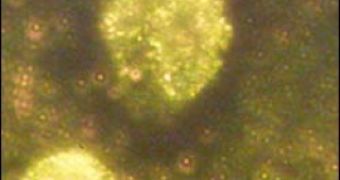Gold seems to be ... 'gold' for the medicine. A Purdue University team has developed gold nanoparticles that can detect marker proteins on breast cancer cells, turning them into a potential tool for an improved diagnose and treatment.
"The technology would be about three times cheaper than the most common current method and has the potential to provide many times the quantity and quality of data. We hope that this technology will soon play a critical role in early detection and monitoring of breast cancer. Our goal is to see it in commercial use in about four years." said lead researcher Joseph Irudayaraj, an associate professor of agricultural and biological engineering.
The gold nanoparticles (nanorods) are even smaller than viruses, and coated with antibodies developed to attach to a specific marker on cell surfaces. These surface markers (which are proteins) can offer valuable information about the type of cell they belong to and its state. "In cancer diagnosis, the ability to accurately detect certain key markers will be very helpful because certain types of cancers have specific surface markers," explained Irudayaraj.
The team had shown that the nanorods, in combination with a special imaging technique, can point to cancer stem cells by attaching to known markers on their surface. Cancer stem cells are the most dangerous, as they spread the cancer cells in the body to other organs (metastasis). The technology uses blood tests, not involving biopsies.
The gold nanoparticles are made so that their size matches their target marker. When they bind to their marker, they "scatter" light in a characteristic manner linked to their dimensions, its antibody and the target cancer marker. "More than 200,000 women are diagnosed with breast cancer every year in the US, and 80 % of those women receive some type of therapy. Since 40 % of them will have a relapse, regular monitoring, which this technology aims to do, is vital," said Irudayaraj.
"Using gold nanorods for cancer detection will be about one-third the cost of the current analogous technology, called flow cytometry. This method works by attaching fluorescent probes to cancer cells, whereas the nanorod technology has its basis in sensing plasmons, or sub-atomic particles present in the gold nanoparticles. The nanorods also require only a few cells, whereas flow cytometry requires hundreds to thousands of cells. This could be advantageous when dealing with scarce sample sizes," he explained.
Irudayaraj's team showed that the nanorods attach to three different markers: two necessary to assess the invasiveness of the cancer cell, and one marker, common in various cancer types, to determine the degree to which the other markers are present. "Gold nanorods may be able to detect as many as 15 different markers in the future, possibly opening the door for even more comprehensive tests.", said Irudayaraj.
After the nanorods are left to attach to specific markers of the cancer cells (if present) in blood samples, the cells are placed on a microscopic slide for imaging and a special camera registers the scattered light, while a computer makes the analysis, delivering the information for the diagnosis.

 14 DAY TRIAL //
14 DAY TRIAL //